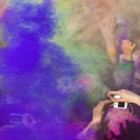Holi (होली) is a spring festival also known as the festival of colours and the festival of love. It is an ancient Hindu religious festival which has become popular with non-Hindus in many parts of South Asia, as well as people of other communities. It is primarily observed in India, Nepal, and other regions of the world with significant populations of Hindus or people of Indian origin. The festival has, in recent times, spread in parts of Europe and North America as a spring celebration of love, frolic and colours.
The frolic and fight with colours occurs in the open streets, open parks, outside temples and buildings. Groups carry drums and musical instruments, go from place to place, sing and dance. People move and visit family, friends and foes, first play with colours on each other, laugh and chit-chat, then share Holi delicacies, food and drinks. In the evening, after sobering up, people dress up, visit friends and family.
Holi is celebrated at the approach of vernal equinox, on the PhalgunaPurnima (Full Moon). The festival date varies every year, per the Hindu calendar, and typically comes in March, sometimes February in the Gregorian Calendar. The festival signifies the victory of good over evil, the arrival of spring, end of winter, and for many a festive day to meet others, play and laugh, forget and forgive, and repair ruptured relationships.
In Nepal, Holi celebrated in Hills is remarkably different from Madhesh, even the festival is celebrated on two different days. Holi is celebrated in the month of Falgun and is also called as the « Fagu/Phaguwa » and is celebrated on the full moon day (in hills) and the day after (in Madhesh) in the month of February. The word « Fagu/Phaguwa » represents the month of Falgun and the day is called the « Fagu Poornima » which means (full moon day in the Falgun).
In Nepal Holi is regarded as one of the greatest festivals as important as Dashain (also known as Dussehra in Madhesh) and Tihar or Dipawali (also known as Diwali in Madhesh). Since more than 80% of people in Nepal are Hindus, Holi, along with many other Hindu festivals, is celebrated in Nepal as a national festival and almost everyone celebrates it regardless of their religion, e.g., even Muslims celebrate it. Christians may also join in, although since Holi falls during Lent, many would not join in the festivities. The day of Holi is also a national holiday in Nepal.
People walk down their neighbourhoods to celebrate Holi by exchanging colours and spraying coloured water on one another. A popular activity is the throwing of water balloons at one another, sometimes called lola (meaning water balloon). Also a lot of people mix bhang in their drinks and food, as is also done during Shivaratri. It is believed that the combination of different colours at this festival take all the sorrow away and make life itself more colourful.







 Classé dans---> Les actions diverses. ----Cliquez ici pour voir ---> Décider Ensemble
Classé dans---> Les actions diverses. ----Cliquez ici pour voir ---> Décider Ensemble